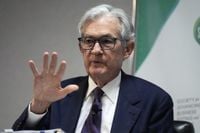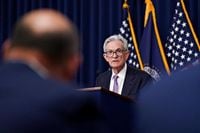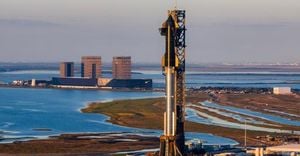On Wednesday, May 7, 2025, Federal Reserve Chair Jerome Powell is set to address the nation following the central bank's decision to maintain interest rates amid growing economic uncertainty. This decision comes in the wake of President Donald Trump's aggressive trade agenda, which has sparked concerns over inflation and unemployment.
The Federal Reserve's interest rate committee opted to keep rates steady, despite mounting pressure from Trump, who has criticized Powell's leadership and the Fed's policies. In recent weeks, Trump has hurled insults at Powell, yet he recently stated he has no intention of ousting him. This dynamic has created a complicated relationship between the President and the Fed chair, with markets reacting wildly to Trump's tariff decisions.
Powell's remarks will follow the Fed's official announcement that the risks of higher unemployment and inflation have increased. "Right now we see inflation kind of moving sideways at a fairly low level," Powell noted, indicating that while inflation remains stable, the economic outlook is fraught with uncertainty. The Fed's decision to hold rates steady reflects a cautious approach as they navigate the potential fallout from Trump's tariffs, which could slow growth while simultaneously raising prices.
Trump's tariffs have placed Powell in a precarious position, where any economic slowdown could lead to increased blame directed at the Fed chair. The President's recent calls for "preemptive cuts" have added political pressure to the Fed's decision-making process. In a post on Truth Social, Trump stated, "There can be a SLOWING of the economy unless Mr. Too Late, a major loser, lowers rates." This rhetoric underscores the tense atmosphere surrounding the Fed's actions as they strive to maintain independence amidst political pressures.
Despite the challenges posed by Trump's trade policies, Powell and the Fed are committed to making decisions based on economic data rather than political influence. The central bank's rate-setting committee acknowledged that while economic activity remains solid, the potential impacts of tariffs on households and the broader economy are significant.
Looking ahead, traders are pricing in a high likelihood of rate cuts later this year, particularly in July, as the labor market shows signs of strain. The Fed's decision to hold rates steady for now suggests they are waiting for more data to assess the impact of Trump's tariffs on economic growth. Powell's cautious approach reflects a broader strategy to avoid surprising the markets, which could lead to further volatility.
As the economic landscape evolves, Powell's leadership will be tested. The Fed's recent statement highlighted the ongoing uncertainty, noting that the outlook has "increased further" in light of trade tensions. This acknowledgment signals that the Fed is aware of the complexities of the current economic environment and is prepared to act if necessary.
The relationship between Trump and Powell has a history marked by tension. Initially appointed by Trump, Powell has faced scrutiny from the President, particularly when the Fed raised interest rates during his first term. The President's threats to remove Powell were ultimately tempered by negative market reactions, illustrating the delicate balance the Fed must maintain between political pressures and economic realities.
Economists warn that recessions are not always immediately visible in employment data, suggesting that the Fed may need to act preemptively to address potential economic downturns. Preston Mui, a senior economist at Employ America, emphasized that the Fed's decisions should be grounded in data, as waiting for clear signs of economic weakness could place them behind the curve.
As Powell prepares to address the nation, the focus will be on how the Fed plans to navigate the challenges posed by Trump's tariffs and the potential for economic slowdown. Investors are keenly watching for signals that could indicate future rate cuts, especially in light of the Fed's commitment to transparency and data-driven decision-making.
In the meantime, the Fed's decision to hold rates steady reflects a broader strategy to mitigate risks associated with Trump's trade policies. The central bank is tasked with balancing the dual mandate of promoting maximum employment and stable prices, a challenge that has become increasingly complex in today's economic climate.
As the news conference approaches, Powell's remarks will be closely scrutinized by economists, investors, and policymakers alike. The outcomes of this meeting could have significant implications for the U.S. economy, especially as the nation grapples with the potential fallout from ongoing trade tensions.
In summary, the Federal Reserve's decision to maintain interest rates amid rising economic uncertainty underscores the challenges facing Powell and the central bank. With political pressures mounting from Trump and concerns about inflation and unemployment on the rise, the Fed's path forward will require careful navigation of both economic data and political dynamics.





